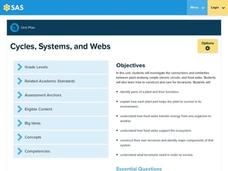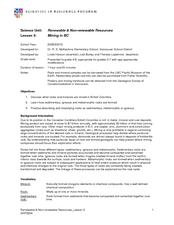Curated OER
Thermal Decomposition of Calcium Carbonate
In this thermal decomposition of calcium carbonate activity, students perform three experiments on calcium carbonate, make observations and write the equations for each reaction. Students explain in detail what happened at each step and...
Curated OER
Heat of an Unknown Metal
Eighth graders complete labs to find the specific heat of many different types of substances, and use characteristic property to identify an unknown metal. CBL be used to determine energy lost or gained, and students complete a...
Curated OER
Chem 152-Electrochemistry
In this electrochemistry instructional activity, students solve a variety of problems including identifying parts of oxidation and reduction reactions, writing balanced equations for galvanic cells, determining free energy and...
Curated OER
Designing Musical Instruments
Students examine musical instruments as main part of the study of sound energy. In this designing instruments lesson plan, students focus on the elements of an instrument that cause sound to be created and design a unique musical...
Curated OER
They Don't Just Eat Grass
Middle schoolers consider the USDA daily recommendations to create a "feed" product for middle schoolers. For this Health lesson, students learn about the ingredients in feed that is fed to livestock and apply the method to creating feed...
Pennsylvania Department of Education
Cycles, Systems, and Webs
Fourth graders review the parts of the plant and their functions. In this plant lesson plan, 4th graders recognize that plants must transfer energy to make food. Students understand the interdependence of organisms in an ecosystem.
Curated OER
Environmental Responsibility
Young scholars discuss the importance of recycling and preventing pollution. In groups, they complete mini-studies on various environmental issues and evaluate different consumer products. They use global warming data to determine the...
Curated OER
fun with Plants that We Use
Students become familiar with the products made from various plants. In this plants lesson plan, students experiment with natural dyes from plants. Students complete a list of things made from plants. Students answer questions about...
Curated OER
Renewable and Non-Renewable Resources: Mining in B.C.
Students explore energy by categorizing rocks. In this British Columbia geology lesson, students define many different vocabulary terms associated with mining such as sedimentary, igneous, and metamorphic. Students utilize sample rock...
Curated OER
Chemical Formulas
Students assess how to go from writing ionic chemical formulas to nomenclature and naming chemical compounds. They brainstorm former studies and share their thoughts in small groups. A list of everyday products (shampoos, toothpaste,...
Curated OER
Submersible Designer
Students work in groups to design, build, and test a submersible prototype. In this engineering lesson, students learn about the importance and design of submersible vessels and apply their knowledge by building one of their own. They...
Curated OER
Chemistry in Action
In this chemistry in action worksheet, students read about sulphuric acid, the use of metals, the production of titanium and the detection of chemical elements and compounds. Students are given 8 statements about what they should know...
Curated OER
A Tough Nut to Crack
Sixth graders explore agriculture by examining world geography. In this pecan cultivation lesson plan, 6th graders identify the history of the famous nut and the impact it has on the U.S. economy, diet and human body. Students define...
Curated OER
See the Wind
Learners explore alternative energy sources. In this wind energy activity, students will investigate the difference in the speed and smoothness of wind at different altitudes above earth. Learners will use kites, helium balloons,...
Curated OER
Enthalpy and Entropy
An entertaining presentation introduces both enthalpy and entropy. It explains equilibrium as the balance between these two measures and provides simple diagrams and graphics for additional clarity.
Discovery Education
Cushion It!
Sugar cubes, collide! Groups design protection systems using bubble wrap to protect sugar cubes from being destroyed by falling batteries in the STEM lesson. They consider how the experiment relates to collisions in real-world...
It's About Time
Photosynthesis, Respiration, and the Carbon Cycle
Provide your class with the opportunity to view our carbon cycle close up. Young scientists research the cycle of oxygen as it completes the tasks of photosynthesis and respiration. They explore the importance of carbon in an ecosystem...
Laboratory for Atmospheric and Space Physics
A Classroom Solar System
Create a scaled model of our solar system in your classroom! Scholars work collaboratively to build paper mache planets and hang them in their proper position to showcase each planet's location in the solar system.
Mr. E. Science
Chemical Reactions
Once I told a chemistry joke, but there was no reaction. Get young chemists involved in changes and reactions with a presentation that begins with physical and chemical changes and chemical reactions. It moves on to chemical equations...
Teach Engineering
Fun With Nanotechnology
Introduce your class to nanotechnology applications with three demonstrations that showcase scientific principles related to ferrofluids, quantum dots, and gold nanoparticles. Groups will work more closely with these applications in the...
Curated OER
Fossil Fuels--Discoveries and Uses
Student examine the close relationship between fossil energy and our daily lives. To demonstrate to the student the close relationship between fossil energy and our daily lives.
Curated OER
Fossil Fuels-Importance and Formation
Student is introduced to the concept of energy as a common factor among all things. They list three fossil fuels and describe how fossil fuels were formed. They then tell how much plant debris it took to form one foot of coal.
Curated OER
Oh Nuts! - Calories Count
Students measure and record the mass of the nut to be tested to the nearest 0.01 gram.
Curated OER
The Elastic Racquet
High schoolers use this introductory lab using a tennis racquet, however it is very difficult to study because of the strings and the racquet stretch so little and so quickly during a match that students were unable to make simple...

























